Introduction
In today’s 5G networks, the amount of traffic between the user and the base station (the uplink) and vice versa (the downlink) is often asymmetrical (because users download more than they upload).
In FDD (Frequency Division Duplex) bands the channel size is the same for both directions. At the same time, more advanced features such as 256QAM modulation and higher-order MIMO (4×4) are typically limited to the downlink, thereby supporting the increased download capacity demands. A focus on downlink capacity has worked out well so far.
However, as traffic patterns are changing, more uplink-heavy applications are anticipated (e.g. cloud storage and personal broadcasting) and flexibility with uplink and downlink spectrum usage is desirable.
Time Division Duplex (TDD) is becoming increasingly common and important to increase flexibility and make spectrum usage more efficient. TDD uses the same frequency for each duplex direction, with a frame that includes different time periods and slots for uplink or downlink communications. By changing the duration of these, network performance can be tailored to meet different needs and help provide the best possible experience.
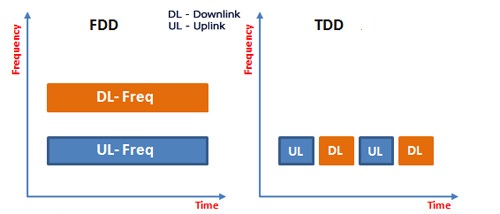
FDD Vs. TDD
5G Spectrum Bands and Duplex Modes
A key advantage of 5G is that it supports a variety of usage scenarios, such as eMBB (enhanced mobile broadband), URLLC (ultra-reliable low-latency communications) and mMTC (massive Machine Type Communication).
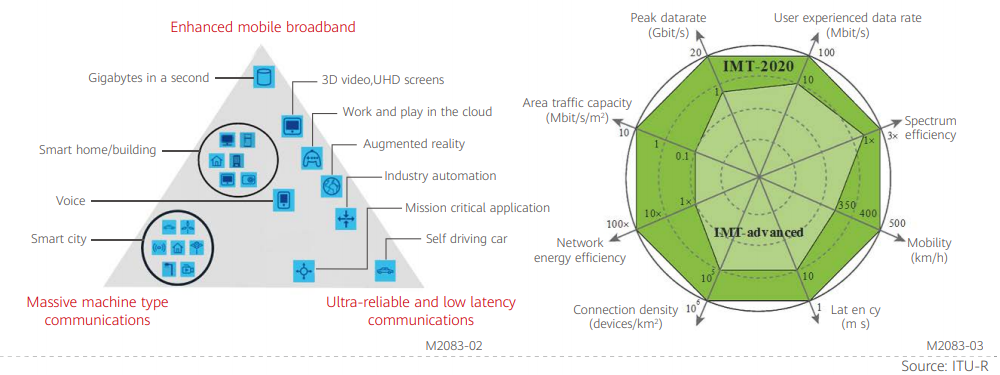 To address diversified requirements from the envisioned usage scenarios in different phases of 5G, 5G needs access to “high”, “mid” and “low” frequency bands (Figure 3), exploiting specific characteristics of different portions of the spectrum: frequencies between 2 and 8 GHz (e.g., 3300-4200, 4400-5000, 2500- 2690, 2300-2400, and 5925-7125 MHz) in combination with frequencies below 2 GHz (e.g. 700 MHz) and above 8 GHz (e.g. 24.25-29.5 and 37-43.5 GHz).
To address diversified requirements from the envisioned usage scenarios in different phases of 5G, 5G needs access to “high”, “mid” and “low” frequency bands (Figure 3), exploiting specific characteristics of different portions of the spectrum: frequencies between 2 and 8 GHz (e.g., 3300-4200, 4400-5000, 2500- 2690, 2300-2400, and 5925-7125 MHz) in combination with frequencies below 2 GHz (e.g. 700 MHz) and above 8 GHz (e.g. 24.25-29.5 and 37-43.5 GHz).

5G Spectrum Bands
Mid-band 3.5GHz is crucial to support most 5G usage scenarios in wide areas. The unpaired (TDD) bands at 3300-4200, 4400-5000, 2500-2690, and 2300-2400 MHz deliver the best compromise between wide-area coverage and high capacity.
Example of Mid-band 5G Frequency Bands:
- n77 (3300 MHz – 4200 MHz) -> TDD.
- n78 (3300 MHz – 3800 MHz) -> TDD.
- n79 (4400 MHz – 5000 MHz) -> TDD.
Different scenarios require customized performance characteristics, so getting the right uplink to downlink duration ratio is very important. As the multiplicity of configurations could lead to coexistence issues, getting TDD Synchronization right is very important for the development of 5G.
What is Synchronisation?
Synchronization between TDD mobile networks refers to parameters that make sure adjacent networks send and receive data from mobile or fixed devices simultaneously to avoid interference.
Different interference scenarios may occur when two TDD networks are deployed in blocks within the same band (including the co-channel case and the adjacent channel case). Crosslink interference will occur when simultaneous transmissions in uplink (UL) and downlink (DL) directions take place in different TDD networks (i.e. one BS (or MS) belonging to one network transmits while another BS (or MS) belonging to the other network receives.

Interference scenarios
5G 3.5GHz Frequency Band TDD
5G in 3.5 GHz frequency band uses a time duplexing (TDD) method.
The TDD duplexing method has two main advantages:
- Improve beam management compared to the FDD method. The Massive-MIMO operation making it possible to rely on the estimations of the channel in reception to implement an analog coding at the level of the transmission antennas in order to orient the beam in a given direction.
- Increase the downstream flow at the expense of the upward flow by proposing more time allocation for the downstream direction compared to the upstream direction. In the case of 5G, the ratio is 4 slots for the downstream direction against one slot for the upstream direction.
5G Frame Structure in TDD Mode
A slot in NR comprises seven or 14 OFDM symbols for ≤ 60kHz numerologies and 14 OFDM symbols for ≥ 120kHz numerologies. A slot duration also scales with the chosen numerology since the OFDM symbol duration is inversely proportional to its subcarrier spacing.
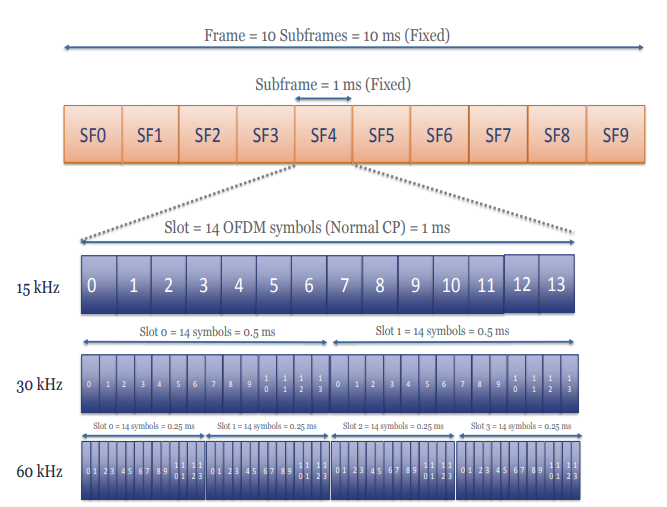
5G Frame Structure
Examples for TDD, with guard periods for UL/DL switching.
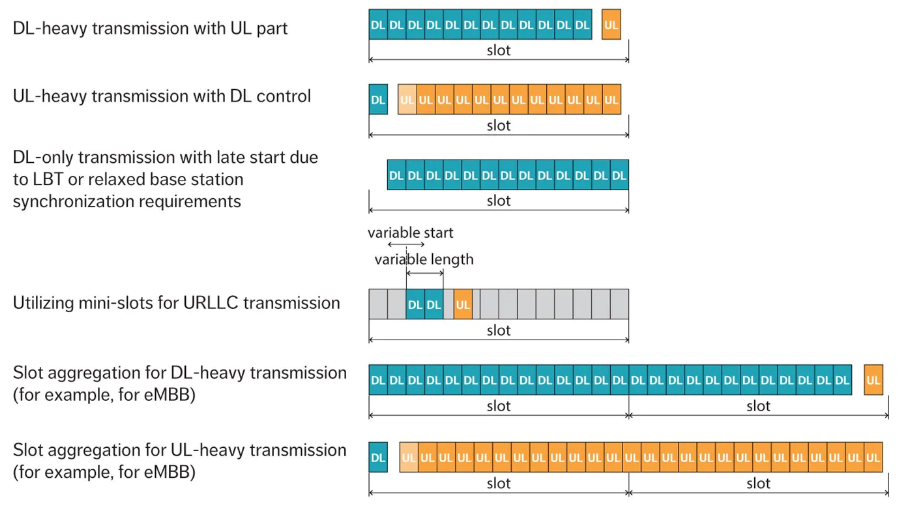
TDD-based frame structure examples for eMBB, URLLC
5G NR Frame Format in 3.5GHz
The allocation of slots proposed by ARCEP follows the recommendation ECC 20 (03), adopted in October 2020. This recommendation limits the number of 5G frames to the following two formats:
- DDDSUUDDDD / DDDDDDDSUU (compatible with TD-LTE), The frame structures DDDDDDDSUU (with a 3ms shift)
or DDDSUUDDDD provides the best compromise for performance where coexistence with incumbent LTE systems is required.
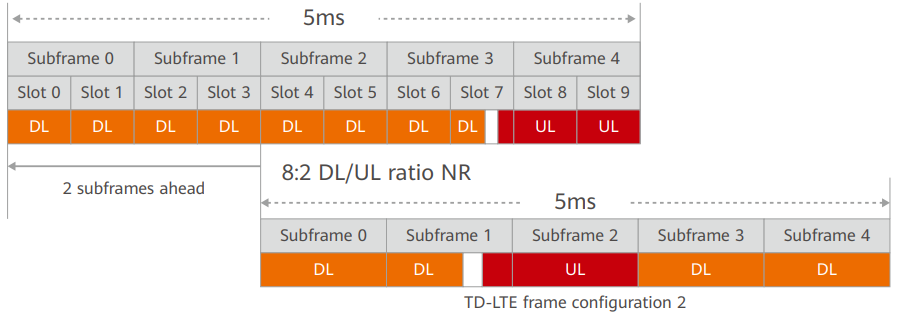
- DDDSU (5G compatible format), The frame structure DDDSU provides the best compromise for performance where coexistence between 5G NR systems is required.

D for Downlink, U for Uplink, S is a special subframe for switching from the direction of transmission D to U.
The first choice has the advantage of compatibility with the LTE frame structure used by French networks and The second choice is not compatible with LTE. These two frames, which are incompatible with each other, will require new functionalities to avoid interference at borders.
Although choosing a 5G NR compatible frame format may be better from a radio latency point of view, its impact from an end-to-end system point of view would be much less visible in first-generation 5G networks. This is mainly due to the 5G NSA (non-standalone) architecture (with 4G core network) and long distances between network elements, which makes the end-to-end latency dominated by the non-radio part.
With the migration to the 5G SA (standalone) core network and the introduction of edge computing, the benefits of the 5G-compatible TDD format would be more visible. Such evolution would probably take a couple of years and in the meantime, using a 4G compatible frame format could resolve operators’ operational constraints in areas where LTE networks need to be considered for synchronization.
How to Keep The Synchronization?
To use the spectrum as efficiently as possible, all operators deploying in the same and adjacent areas should implement the same synchronization approach. This should be the case regardless of whether the license is local, nationwide, or regional. To ensure coexistence at a national level, it is strongly recommended that all networks operating within the 3.5 GHz range use the same synchronization parameters
That means:
- The default parameters for national TDD synchronization should be defined before awarding the spectrum.
- All networks operating within the 3.5 GHz range use a common 5G NR frame structure.
- All networks should use the same frame structure at a national level.
- Networks should be synchronized at an international level whenever possible.
- Public mobile operators should be permitted to update the agreed national TDD synchronization parameters.
- A common phase clock reference (e.g. UTC) and accuracy/performance constraints depend on the underlining technology either using their own equipment to provide the clock or sharing the same phase/time clock infrastructure.
References:
- Designing for the future: the 5G NR physical layer, Ericsson.
- Multiple Operator Network Coexistence in the Same Frequency bands, GTI.
- 5G Spectrum, Huawei
- 5G and LTE-TDD Synchronized Coexistence with Blind Retransmission and Mini-Slot Uplink.
- Guidelines and Recommendations for the Coexistence of TDD Networks in the 3.5 GHz Range, GSMA.
- ECC Report 296.












